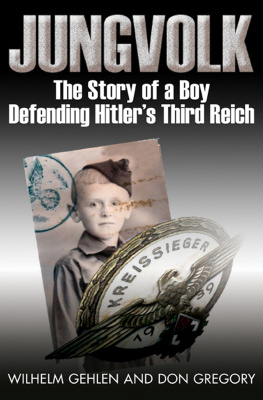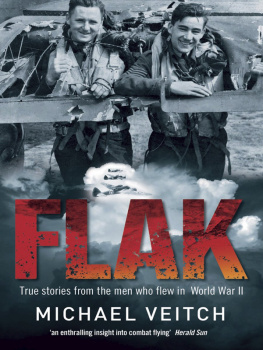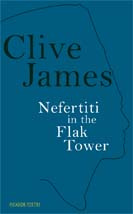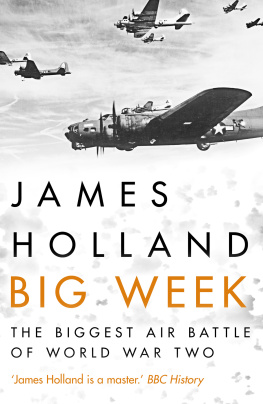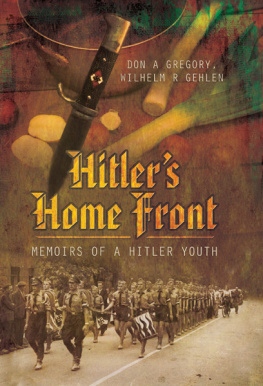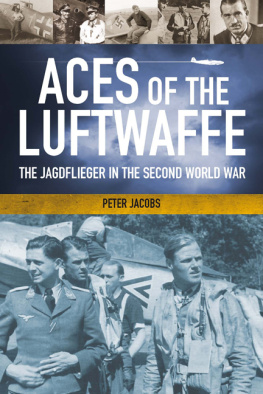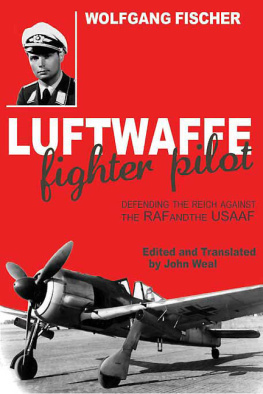

Published in the United States of America in 2008 by
CASEMATE
1016 Warrior Road, Drexel Hill, PA 19026
and in the United Kingdom by
CASEMATE
17 Cheap Street, Newbury, Berkshire, RG14 5DD
2008 by Wilhelm R. Gehlen & Don A. Gregory
ISBN 978-1-932033-87-8
Cataloging-in-publication data is available from the Library of Congress and from the British Library
All rights reserved. No part of this publication may be reproduced, stored in a retrieval system or transmitted, in any form or by any means, electronic, mechanical, photocopying, recording or otherwise, without the prior permission of the publishers.
Printed and Bound in the United States of America
For a complete list of Casemate titles, please contact
United States of America
Casemate Publishers
Telephone (610) 853-9131, Fax (610) 853-9146
E-mail casemate@casematepublishing.com
Website www.casematepublishing.com
United Kingdom
Casemate-UK
Telephone (01635) 231091, Fax (01635) 41619
E-mail casemate-uk@casematepublishing.co.uk
Website www.casematepublishing.co.uk
PREFACE
This book was written more than fifty years after the events described within it happened; therefore, I ask the reader to excuse me if, in some instances, I have my dates or places confused after such a long lapse of time. I have also deliberately changed the names of a few persons, units and places to protect the privacy of those who might still be living among us.
This book describes my life as a young boy as a member of the Deutsches Jungvolk (German Youth) and Hitlerjugend, Bann 39 (HJ; Hitler Youth, Regiment 39), based in Dusseldorf, during and immediately after World War II. The Jungvolk was a branch of the Hitler Youth for younger boys, ten to fourteen years old. My story should not be looked upon as a glorification of National Socialism. I have avoided, wherever possible, descriptions of tasteless or gruesome events that are sadly found all too often in publications about the war.
To the reader it might seem rather amazing and unbelievable that the Nazis required children to do their bit for so-called Fhrer, Volk, und Vaterland, and work toward a final victory for Germany, but that is exactly what happened. Our lessons in school, apart from a basic curriculum, revolved around aircraft identification (friendly and enemy), scrap collecting, herb collecting, parades and inspections, and messenger and light antiaircraft (AA) duties. Even collecting Colorado beetles in potato fields was regarded as victory work. In those years, the Hitler Youth were in the fields all summer long, and it can be assumed that the eradication of this pest in Germany is mainly due to the efforts of the school aged boys and girls that collected them until 1948. The Colorado beetle today is not found in Germany.
In 1943 I was ten years old, and at the age of ten we Jungvolk knew how to change the barrel on a 20mm gun. We loaded magazines and ran messages, often under fighter-bomber fire, between gun emplacements or to headquarters (HQ), when telephone communications had been shot to ribbons. A Hitler Youth knew the sound of a P-38 or a Typhoon making a beeline toward him with cannons blazing. He knew where to take cover in the nearest foxhole. He stood steadfast by the light of AAs, handing magazines to the loader, when around him all hell was breaking loose. It was a total war, where everyone was involved, especially after the Normandy landingsbecause Germany, from that date, was waging a war on two fronts.
In the eyes of our parents, we were still kids; in the eyes of Hitler, we were a convenient substitute for older flak (anti-aircraft) personnel sent to the front to make up for the terrible losses at Stalingrad. It can truly be said that the Hitlerjugend proportionally took as many casualties from fighter bomber attacks as any other Wehrmacht division. The Hitler Youth organization was, in fact, the second oldest paramilitary group in the Third Reich, founded one year after the Sturmabteilung (SA), or Storm Division, the paramilitary organization of the Nazi Party in Germany. Jungvolk and Hitlerjugend also dug up thousands of soccer fields to be used as vegetable plots. They excavated tank traps, and not with heavy equipment either, but with pick and shovelworking, for the most part, on all of these jobs under the constant threat of fighter bomber attacks.
I did not consult any reference books in writing this memoir, but wrote down what I could remember. I would like to say a big thank you to my wife Barbara, who encouraged me in the first place to write all this down, and to Beverly Niekerk for typing the first draft of my notes. I would also like to thank Craig Gottlieb and Vera Crist for the reproduction of a Kreisseiger medal in their collection featured on the books cover.
Lastly, I dedicate this book to all the soldiers of World War II, and to their friends and relatives, both Allied and Axis, who lost their lives in the line of duty. You are not forgotten!
WRG
Telford, Tennessee
2008
I met Will Gehlen some three years ago and soon after making his acquaintance, I began to urge him to tell his story so that others could better understand what things were really like for young boys growing up in Nazi Germany, as experienced by someone who was really there. He finally grew to know me well enough to admit that indeed he had written down some of the things he could remember about that time, and that he would like to see his story published as a book. Being a university professor with an attitude much like Wills Brother Len, whom you will soon meet, I knew I could handle this bit of writing in the span of a few months. Over two years later, it was finally finished. I dont know who was gladder, Will or me.
Will indeed had some notes that had been typed on a typewriter, but these had to be scanned page by page and interpreted. I saw my job as involving more than help with modern hardware and software. I wanted to turn Wills notes into a book that would be readable and informative, as factual as Will and I could make it, and maybe even a bit entertaining. Luckily for me, Will is a fascinating conversationalist, and was always ready to retell a story that was not written down quite right; so a portion of this book is my interpretation and rewriting of his notes, and information I gained from multiple interviews and correspondence.
Wills English is very good, but it was learned by listening to the English of those around him, and sometimes they were not the best teachers. For this reason, some of the notes required further interpretation. This I have done, while trying my best to keep the spirit of the notes and what he told me untouched. Much of the book is written as conversation because that is the way he remembered the events. I have very much enjoyed communicating with him during the preparation of this book, even though it was often difficult to explain to him why I was having so much trouble with the simple task that I told him I could handle so quickly and easily. I would certainly like to acknowledge the assistance of Sean Anderson and Kira Patty for solving some difficult scanning and formatting problems that I could not handle.
You may not recognize the name, Wilhelm Gehlen, but you do know the name of his fathers cousin, whom Will called Uncle, Reinhard Gehlen, better known as the chief of the Gehlen Organization and the true father of Americas CIA.
DAG
Huntsville, Alabama

